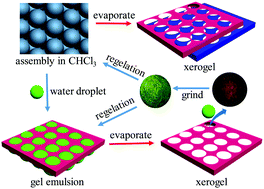Effect of water on the supramolecular assembly and functionality of a naphthalimide derivative: tunable honeycomb structure with mechanochromic properties†
Abstract
An understanding of the synergistic effect of organic systems and water molecules would represent a growing research in the field of designing functional supramolecular architectures. Herein, a novel type of symmetric organogelator, NDS, containing diacetylene and naphthalimide units was designed and characterized. NDS could self-assemble into a large-scale, ordered honeycomb-patterned structure with micron pores via an evaporation method. Interestingly, the micron pores of the honeycomb films could be changed into nanopores upon the addition of water via a spontaneous water-templated process by the formation of gel emulsions. Moreover, the effect of the addition of water on the dye aggregates and their mechanical and optical properties were also studied via several experiments. It was deduced that water could weaken the intermolecular interaction of NDS and enhance the degree of J aggregation of naphthalimide fluorophores, thus resulting in thixotropic gel emulsions with large-scale patterned honeycomb structures. The corresponding xerogels with honeycomb structures were very sensitive to gentle grinding, with obvious emission change from red to yellow, showing a grinding chromism property.



 Please wait while we load your content...
Please wait while we load your content...